2011 CHEVROLET CORVETTE seats
[x] Cancel search: seatsPage 106 of 428
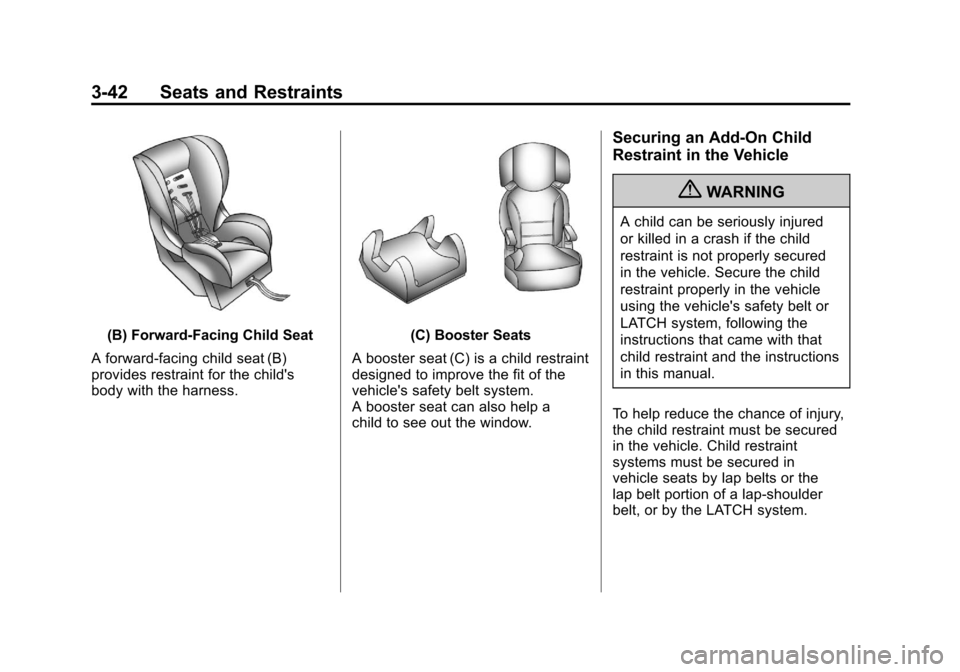
Black plate (42,1)Chevrolet Corvette Owner Manual - 2011
3-42 Seats and Restraints
(B) Forward-Facing Child Seat
A forward-facing child seat (B)
provides restraint for the child's
body with the harness.(C) Booster Seats
A booster seat (C) is a child restraint
designed to improve the fit of the
vehicle's safety belt system.
A booster seat can also help a
child to see out the window.
Securing an Add-On Child
Restraint in the Vehicle
{WARNING
A child can be seriously injured
or killed in a crash if the child
restraint is not properly secured
in the vehicle. Secure the child
restraint properly in the vehicle
using the vehicle's safety belt or
LATCH system, following the
instructions that came with that
child restraint and the instructions
in this manual.
To help reduce the chance of injury,
the child restraint must be secured
in the vehicle. Child restraint
systems must be secured in
vehicle seats by lap belts or the
lap belt portion of a lap-shoulder
belt, or by the LATCH system.
Page 107 of 428
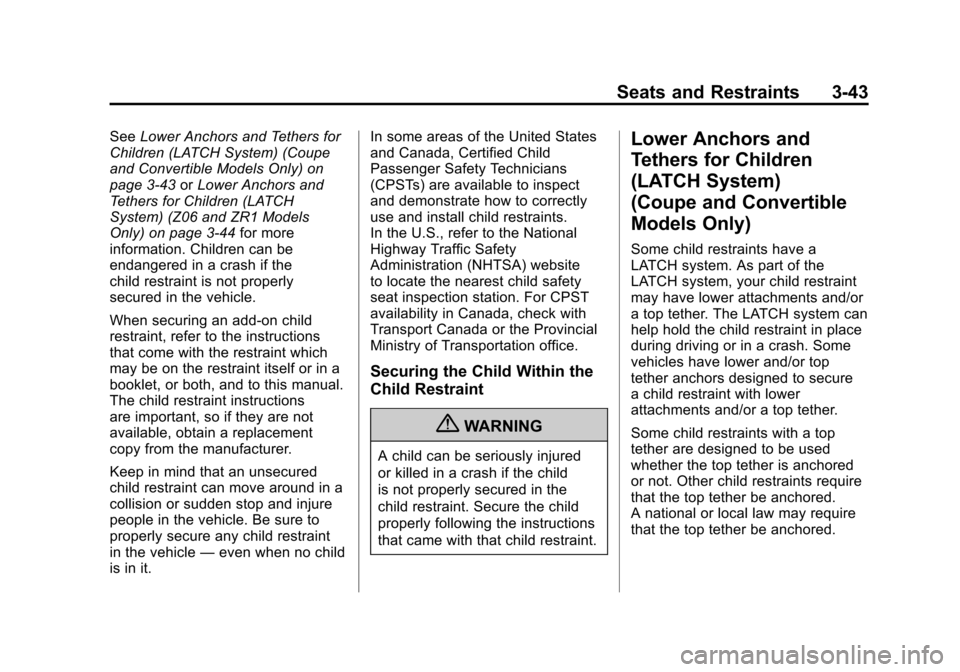
Black plate (43,1)Chevrolet Corvette Owner Manual - 2011
Seats and Restraints 3-43
SeeLower Anchors and Tethers for
Children (LATCH System) (Coupe
and Convertible Models Only) on
page 3‑43 orLower Anchors and
Tethers for Children (LATCH
System) (Z06 and ZR1 Models
Only) on page 3‑44 for more
information. Children can be
endangered in a crash if the
child restraint is not properly
secured in the vehicle.
When securing an add-on child
restraint, refer to the instructions
that come with the restraint which
may be on the restraint itself or in a
booklet, or both, and to this manual.
The child restraint instructions
are important, so if they are not
available, obtain a replacement
copy from the manufacturer.
Keep in mind that an unsecured
child restraint can move around in a
collision or sudden stop and injure
people in the vehicle. Be sure to
properly secure any child restraint
in the vehicle —even when no child
is in it. In some areas of the United States
and Canada, Certified Child
Passenger Safety Technicians
(CPSTs) are available to inspect
and demonstrate how to correctly
use and install child restraints.
In the U.S., refer to the National
Highway Traffic Safety
Administration (NHTSA) website
to locate the nearest child safety
seat inspection station. For CPST
availability in Canada, check with
Transport Canada or the Provincial
Ministry of Transportation office.
Securing the Child Within the
Child Restraint
{WARNING
A child can be seriously injured
or killed in a crash if the child
is not properly secured in the
child restraint. Secure the child
properly following the instructions
that came with that child restraint.
Lower Anchors and
Tethers for Children
(LATCH System)
(Coupe and Convertible
Models Only)
Some child restraints have a
LATCH system. As part of the
LATCH system, your child restraint
may have lower attachments and/or
a top tether. The LATCH system can
help hold the child restraint in place
during driving or in a crash. Some
vehicles have lower and/or top
tether anchors designed to secure
a child restraint with lower
attachments and/or a top tether.
Some child restraints with a top
tether are designed to be used
whether the top tether is anchored
or not. Other child restraints require
that the top tether be anchored.
A national or local law may require
that the top tether be anchored.
Page 108 of 428
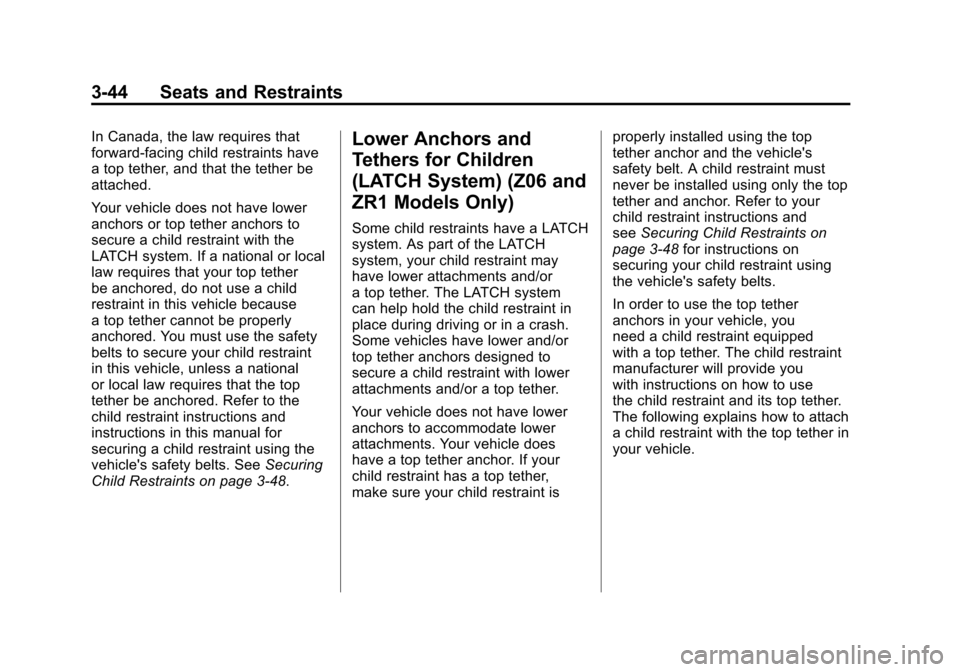
Black plate (44,1)Chevrolet Corvette Owner Manual - 2011
3-44 Seats and Restraints
In Canada, the law requires that
forward-facing child restraints have
a top tether, and that the tether be
attached.
Your vehicle does not have lower
anchors or top tether anchors to
secure a child restraint with the
LATCH system. If a national or local
law requires that your top tether
be anchored, do not use a child
restraint in this vehicle because
a top tether cannot be properly
anchored. You must use the safety
belts to secure your child restraint
in this vehicle, unless a national
or local law requires that the top
tether be anchored. Refer to the
child restraint instructions and
instructions in this manual for
securing a child restraint using the
vehicle's safety belts. SeeSecuring
Child Restraints on page 3‑48.Lower Anchors and
Tethers for Children
(LATCH System) (Z06 and
ZR1 Models Only)
Some child restraints have a LATCH
system. As part of the LATCH
system, your child restraint may
have lower attachments and/or
a top tether. The LATCH system
can help hold the child restraint in
place during driving or in a crash.
Some vehicles have lower and/or
top tether anchors designed to
secure a child restraint with lower
attachments and/or a top tether.
Your vehicle does not have lower
anchors to accommodate lower
attachments. Your vehicle does
have a top tether anchor. If your
child restraint has a top tether,
make sure your child restraint is properly installed using the top
tether anchor and the vehicle's
safety belt. A child restraint must
never be installed using only the top
tether and anchor. Refer to your
child restraint instructions and
see
Securing Child Restraints on
page 3‑48 for instructions on
securing your child restraint using
the vehicle's safety belts.
In order to use the top tether
anchors in your vehicle, you
need a child restraint equipped
with a top tether. The child restraint
manufacturer will provide you
with instructions on how to use
the child restraint and its top tether.
The following explains how to attach
a child restraint with the top tether in
your vehicle.
Page 109 of 428
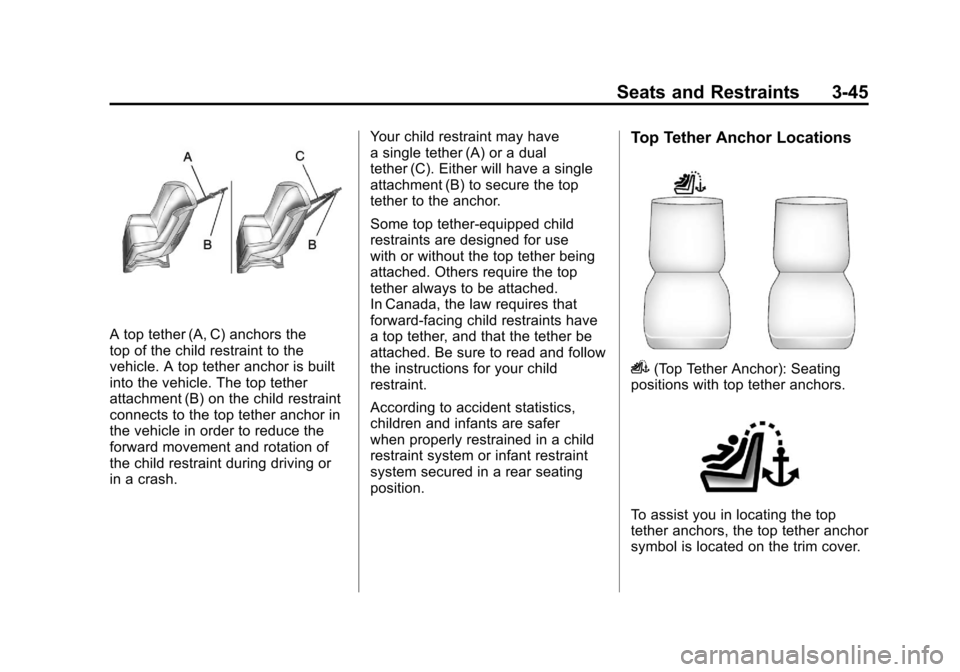
Black plate (45,1)Chevrolet Corvette Owner Manual - 2011
Seats and Restraints 3-45
A top tether (A, C) anchors the
top of the child restraint to the
vehicle. A top tether anchor is built
into the vehicle. The top tether
attachment (B) on the child restraint
connects to the top tether anchor in
the vehicle in order to reduce the
forward movement and rotation of
the child restraint during driving or
in a crash.Your child restraint may have
a single tether (A) or a dual
tether (C). Either will have a single
attachment (B) to secure the top
tether to the anchor.
Some top tether-equipped child
restraints are designed for use
with or without the top tether being
attached. Others require the top
tether always to be attached.
In Canada, the law requires that
forward-facing child restraints have
a top tether, and that the tether be
attached. Be sure to read and follow
the instructions for your child
restraint.
According to accident statistics,
children and infants are safer
when properly restrained in a child
restraint system or infant restraint
system secured in a rear seating
position.
Top Tether Anchor Locations
i(Top Tether Anchor): Seating
positions with top tether anchors.
To assist you in locating the top
tether anchors, the top tether anchor
symbol is located on the trim cover.
Page 110 of 428
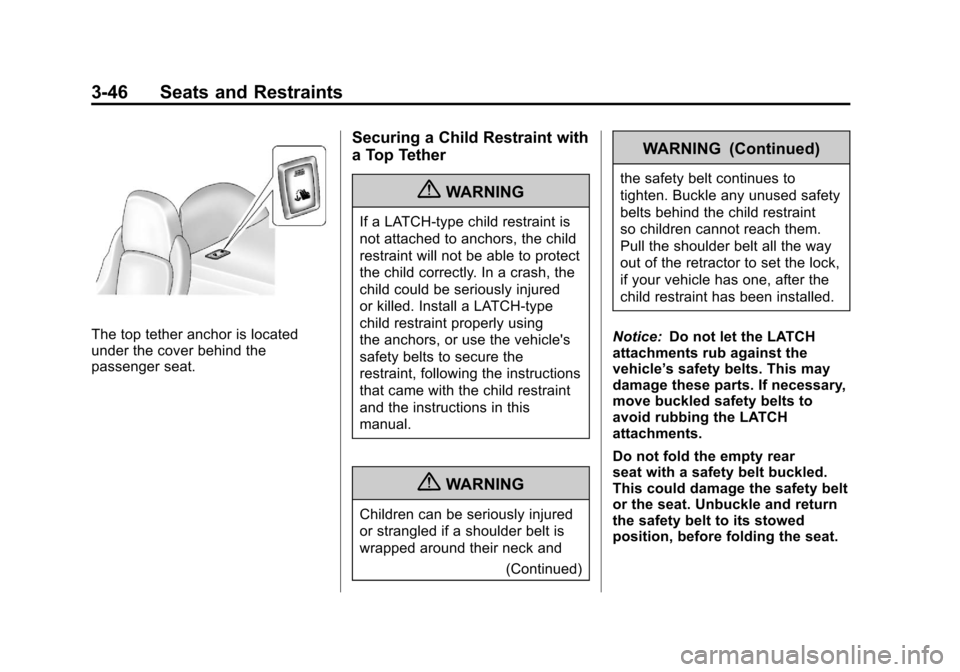
Black plate (46,1)Chevrolet Corvette Owner Manual - 2011
3-46 Seats and Restraints
The top tether anchor is located
under the cover behind the
passenger seat.
Securing a Child Restraint with
a Top Tether
{WARNING
If a LATCH-type child restraint is
not attached to anchors, the child
restraint will not be able to protect
the child correctly. In a crash, the
child could be seriously injured
or killed. Install a LATCH-type
child restraint properly using
the anchors, or use the vehicle's
safety belts to secure the
restraint, following the instructions
that came with the child restraint
and the instructions in this
manual.
{WARNING
Children can be seriously injured
or strangled if a shoulder belt is
wrapped around their neck and(Continued)
WARNING (Continued)
the safety belt continues to
tighten. Buckle any unused safety
belts behind the child restraint
so children cannot reach them.
Pull the shoulder belt all the way
out of the retractor to set the lock,
if your vehicle has one, after the
child restraint has been installed.
Notice: Do not let the LATCH
attachments rub against the
vehicle’ s safety belts. This may
damage these parts. If necessary,
move buckled safety belts to
avoid rubbing the LATCH
attachments.
Do not fold the empty rear
seat with a safety belt buckled.
This could damage the safety belt
or the seat. Unbuckle and return
the safety belt to its stowed
position, before folding the seat.
Page 111 of 428

Black plate (47,1)Chevrolet Corvette Owner Manual - 2011
Seats and Restraints 3-47
Do not secure a child restraint in a
position without a top tether anchor
if a national or local law requires
that the top tether be attached, or if
the instructions that come with the
child restraint say that the top tether
must be attached.
1. Secure the child restraintusing the vehicle's safety belt.
See Securing Child Restraints
on page 3‑48.
2. If the child restraint manufacturer recommends that the top tether
be attached, attach and tighten
the top tether to the top tether
anchor, if equipped. Refer to the
child restraint instructions and
the following steps:
2.1. Find the top tether anchor.
2.2. Press the ribbed area of the
trim cover to open the cover
and expose the anchor. 2.3. Route, attach and tighten
the top tether according
to your child restraint
instructions and the
following instructions:
If the position you are using
has a fixed headrest or
head restraint and you are
using a single tether, route
the tether over the headrest
or head restraint.
If the position you are using
has a fixed headrest or
head restraint and you are
using a dual tether, route
the tether around the
headrest or head restraint.
3. Before placing a child in the child restraint, make sure it is
securely held in place. To check,
grasp the child restraint at
the LATCH path and attempt
to move it side‐to‐side and
back‐and‐forth. There should
be no more than 2.5 cm (1 in) of
movement for proper installation.
Page 112 of 428
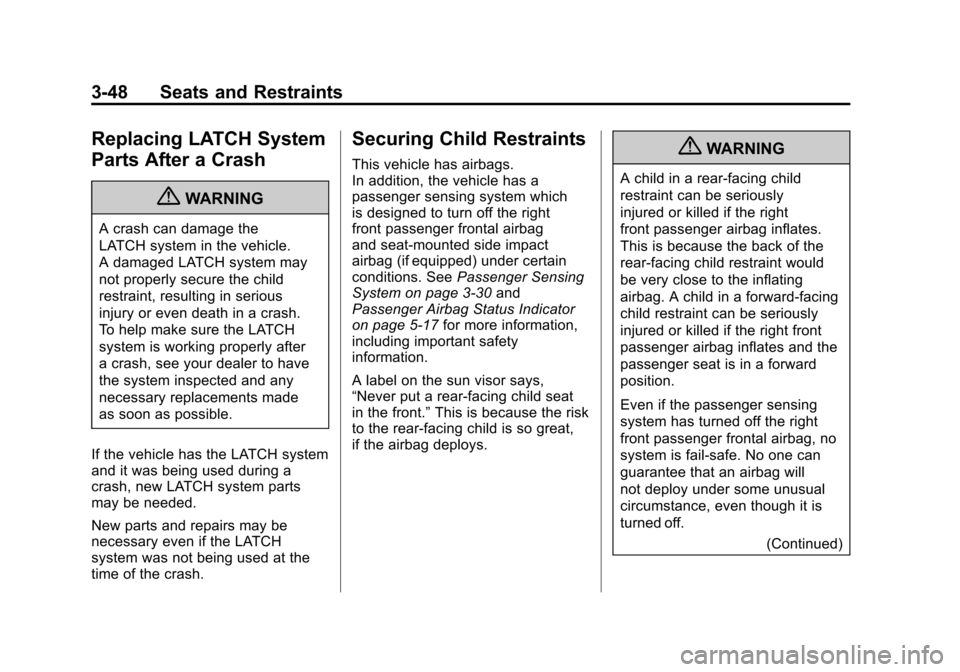
Black plate (48,1)Chevrolet Corvette Owner Manual - 2011
3-48 Seats and Restraints
Replacing LATCH System
Parts After a Crash
{WARNING
A crash can damage the
LATCH system in the vehicle.
A damaged LATCH system may
not properly secure the child
restraint, resulting in serious
injury or even death in a crash.
To help make sure the LATCH
system is working properly after
a crash, see your dealer to have
the system inspected and any
necessary replacements made
as soon as possible.
If the vehicle has the LATCH system
and it was being used during a
crash, new LATCH system parts
may be needed.
New parts and repairs may be
necessary even if the LATCH
system was not being used at the
time of the crash.
Securing Child Restraints
This vehicle has airbags.
In addition, the vehicle has a
passenger sensing system which
is designed to turn off the right
front passenger frontal airbag
and seat-mounted side impact
airbag (if equipped) under certain
conditions. See Passenger Sensing
System on page 3‑30 and
Passenger Airbag Status Indicator
on page 5‑17 for more information,
including important safety
information.
A label on the sun visor says,
“Never put a rear-facing child seat
in the front.” This is because the risk
to the rear-facing child is so great,
if the airbag deploys.{WARNING
A child in a rear-facing child
restraint can be seriously
injured or killed if the right
front passenger airbag inflates.
This is because the back of the
rear-facing child restraint would
be very close to the inflating
airbag. A child in a forward-facing
child restraint can be seriously
injured or killed if the right front
passenger airbag inflates and the
passenger seat is in a forward
position.
Even if the passenger sensing
system has turned off the right
front passenger frontal airbag, no
system is fail-safe. No one can
guarantee that an airbag will
not deploy under some unusual
circumstance, even though it is
turned off.
(Continued)
Page 113 of 428

Black plate (49,1)Chevrolet Corvette Owner Manual - 2011
Seats and Restraints 3-49
WARNING (Continued)
Secure rear-facing child
restraints in a rear seat, even if
the airbag is off. If you secure a
forward-facing child restraint in
the right front seat, always move
the front passenger seat as far
back as it will go. It is better to
secure the child restraint in a
rear seat.
SeePassenger Sensing System
on page 3‑30 for additional
information.
Rear-facing child restraints should
not be installed in the vehicle, even
if the airbag(s) are off.
If the child restraint has the LATCH
system, see Lower Anchors and
Tethers for Children (LATCH
System) (Coupe and Convertible
Models Only) on page 3‑43 or
Lower Anchors and Tethers for Children (LATCH System) (Z06 and
ZR1 Models Only) on page 3‑44
for
how and where to install the child
restraint using LATCH. If a child
restraint is secured using a safety
belt and it uses a top tether, see
Lower Anchors and Tethers for
Children (LATCH System) (Coupe
and Convertible Models Only) on
page 3‑43 orLower Anchors and
Tethers for Children (LATCH
System) (Z06 and ZR1 Models
Only) on page 3‑44 for top tether
anchor locations.
Do not secure a child seat in a
position without a top tether anchor
if a national or local law requires
that the top tether be anchored, or if
the instructions that come with the
child restraint say that the top strap
must be anchored.
In Canada, the law requires that
forward-facing child restraints have
a top tether, and that the tether be
attached. You will be using the lap-shoulder
belt to secure the child restraint in
this position. Follow the instructions
that came with the child restraint.
1. Move the seat as far back as
it will go before securing the
forward-facing child restraint.
When the passenger sensing
system has turned off the right
front passenger frontal airbag
and seat-mounted side impact
airbag (if equipped), the off
indicator on the passenger
airbag status indicator should
light and stay lit when you start
the vehicle. See Passenger
Airbag Status Indicator on
page 5‑17.
2. Put the child restraint on the seat.
3. Pick up the latch plate, and run the lap and shoulder portions of
the vehicle’ s safety belt through
or around the restraint. The child
restraint instructions will show
you how.